Warm mohair knitted sweater knitting needles, according to the patterns and descriptions given below, can be not only beautiful, but also stylish. Due to the peculiarity of the thread, it will in any case warm even on a harsh winter day, but the choice of the model and knitting pattern will determine its style.
Selection of yarn and knitting needles
Mohair is an unusual soft and fluffy thread. It consists of a base, which can have a different composition, and fluffy wool fibers. The wool is strung on the base in a special way without strong twisting. This determines the fluffiness of the thread and its properties. Mohair is one of the warmest threads. It is used to create warm and cozy winter items, in particular sweaters.
An important feature of this yarn is its lightness and airiness. Mohair consumption is always small. A thing made of this yarn will be light and airy. There are several varieties of mohair by composition and thickness of the thread. They are presented in the table.
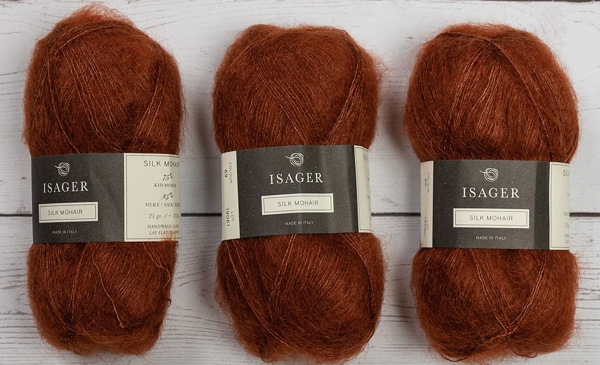
Table
| Compound | Footage | |
| Mohair on a synthetic base | 50-70% acrylic; 50-30% wool | 500 m in 100 g of yarn |
| Natural mohair | 50-70% silk; 50-30% wool | 500 m in 100 g of yarn |
| Kid mohair on a synthetic base | 50-70% acrylic; 50-30% wool | 250 m in 25 g yarn |
| Kid mohair on a natural basis | 50-70% silk; 50-30% wool | 250 m in 25 g yarn |
Kid mohair is a very thin thread, but you need to choose fairly thick knitting needles for work, at least 3.5. Products made from this yarn are weightless, translucent. At the same time, they are very warm. This thread can be used for knitting with satin stitch or openwork.
Regular mohair can be supplemented with lurex thread or sequins. Such yarn should be used for elegant sweaters that are suitable for special occasions. Mohair is usually knitted with knitting needles No. 4-5 or larger.
The choice of knitting needles depends on the idea, the knitting pattern and the knitting features. If the craftswoman knits tightly, then it is worth choosing a larger number of knitting needles so that the thread lies freely and reveals all its properties in the fabric.
Mohair is suitable for sweaters:
- knitted with satin stitch;
- elastic band (regular or voluminous);
- openwork pattern.
The amount of yarn should be chosen based on the description of a specific model and the size of the product. For a regular sweater with a satin stitch of size 44-46, 200-300 g of mohair may be enough.
The different composition of mohair determines its cost. Mohair or kid mohair on acrylic will cost about 200 rubles per 100 gram skein. Thread on silk will cost 2 or 3 times more. In terms of tactile sensations, the composition of the thread base is not decisive. Mohair will always be very soft. Kid mohair is considered a more delicate thread.
Sweater with English ribbing from mohair
A knitted mohair sweater, the diagrams and description of which are given below, is suitable for every day for young or adult women.
This model is knitted from 4 parts:
- back;
- front part;
- 2 sleeves.
After assembling all the parts, you need to pick up the loops along the neck and knit the collar on circular needles. To knit this sweater, it is better to use regular mohair with a footage of 500 m per 100 g. If knitting from kid mohair, it is better to work in 3-4 folds of thread so that the pattern holds its shape.
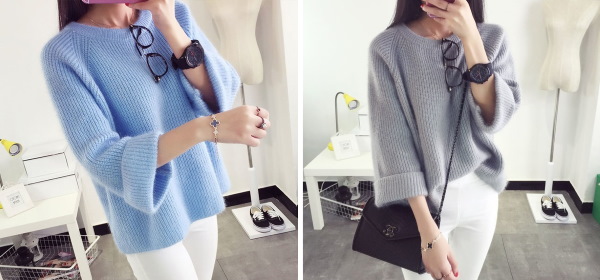
The main pattern used in the work is English elastic. It looks spectacular and voluminous in the finished product. This is a double-sided elastic that resembles a regular 1 by 1 elastic, but is voluminous and more spectacular. Usually requires more yarn consumption, which makes the sweater heavier. But if you knit from mohair, then the thread consumption is very small and the thing will be light.
To knit English elastic, follow the following pattern:
- You can knit on an even or odd number of loops. Loops can be cast on in any convenient and familiar way.
- The 1st row is basic and is knitted in a special way: 1 edge stitch, 1 front stitch, slip the next stitch purlwise together with the yarn over. Repeat this to the end of the row, to the last 2 stitches. Knit the second to last stitch as a front stitch, and the edge stitch as a purl stitch (if there is an even number of stitches). If there is an odd number of stitches in the work, then finish the row with a purl stitch, slipped with a yarn over and one edge stitch.
- The second row is knitted as follows: 1 edge, then a purl loop follows the pattern, remove it purlwise with a yarn over, then a front loop with a yarn over follows the pattern, knit these 2 loops as a regular front loop. Repeat to the end, knit the last outer loop of the row purlwise, like an edge loop. If there is an even number of loops in the work, then there will be a front loop before the edge loop.
- Knit all subsequent rows according to the description of the second row.
A sweater knitted from mohair according to the patterns and description for this model will turn out dense if you choose thin knitting needles for work.
If you choose a tool of a larger number, the canvas will be looser and lighter. It all depends on your desire and taste.Before you start working, you need to calculate the knitting density to determine the number of loops.
To do this, it is important to knit a small sample of the selected thread and selected knitting needles with English rib. You can cast on 25-30 loops and knit about 20 rows. Then you need to draw a pattern for the future sweater, indicate your measurements and calculate the number of loops based on the knitted sample.
Since mohair is a very soft and thin thread, the pattern for such a sweater can be very simple: 2 rectangles for the back and front with a cutout for the neck and two rectangles for the sleeves with a slight expansion towards the armpits.
Knit a sweater like this:
- It is better to start with the back part. Cast on the required number of stitches based on the calculation and knit to the required length without changing the selected pattern. For the neck, close the middle third of all cast on stitches and finish the shoulders separately, knitting another 4-6 rows.


- Then knit the front piece in a similar way, but start closing the neck a little earlier, dividing the number of loops for the neck into 4 parts. First close the middle loops of the neck, then close the remaining loops along the edges of the neck in several parts.
- Knit the sleeves symmetrically. Cast on the required number of stitches and knit upwards, evenly adding 1 stitch every 10 cm on both sides.
Sew all the pieces together, first sew the shoulder seams, then sew the sleeves, then sew the side seams. Pick up the stitches along the neckline on circular knitting needles and knit the collar to the desired length.
The sweater is ready. This is a simple basic model that always looks relevant and will suit any style of clothing. You can change the length and width of the product to your taste, change the cut of the sleeve and armhole, and design the neckline in different ways.
The neck can be:
- stand-up stitch (knit on circular needles to the desired length);
- clamp;
- V-neck;
- round neckline;
- boat.
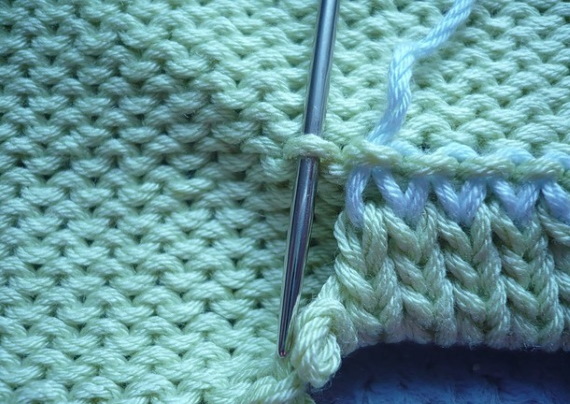
Necklines can be designed in different ways:
- with a wicker basket;
- with a simple garter stitch, then it will be stylishly rounded;
- with elastic band.
This versatile model is very easy to make and gives scope for creativity.
With dropped shoulder
The knitted mohair sweater, the diagrams and description of which follow below, has a very striking feature - a dropped shoulder. This model can be worn during the day for everyday activities and even in the evening, for a special occasion.
This feminine and seductive sweater, made of mohair, will complement a delicate look with trousers or a skirt. Provided that longer details of the back and front are knitted, it can become a tunic or a dress.
This sweater looks very stylish and impressive. Even a beginner craftswoman can knit it, since the knitting here is the simplest. It is knitted from the same parts of the back and front, sleeves and collar.
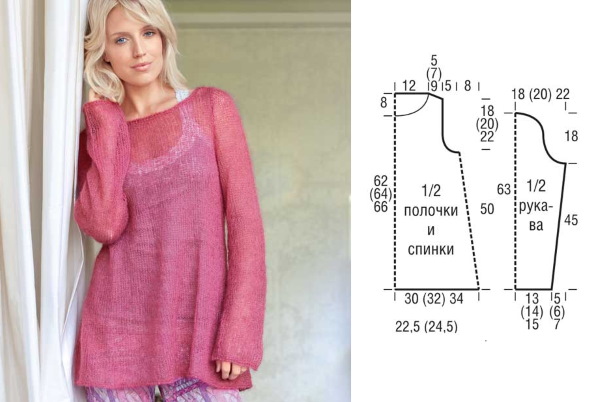
For work it is better to use mohair of any shade. You can take a thread with lurex or sequins. For a denser product you can knit in 2 threads. For this model you need regular straight needles or on a fishing line No. 4.5-6.
You need to start working from the back:
- On 4.5 knitting needles, cast on 75 loops and knit with a regular 2 by 2 elastic band for about 7-8 cm (or any desired height).
- Switch to stockinette stitch and change to knitting needles No. 6. Evenly increase 10 loops in the 1st row of stockinette stitch.
- Then work in a straight line to the required height.
- Switch to knitting needles No. 4.5 and knit 2 by 2 ribbing again to the desired height (approximately 7 cm). Close the loops.
- Knit the front in the same way. You should get 2 identical pieces.
- Then knit the sleeves. Cast on 50 stitches on knitting needles #4.5 and knit a 2 by 2 elastic band. Add 10 stitches and knit with the front surface to the desired height. In this case, in each 10th row, you need to add 1 stitch from each edge. Knit 2 parts.
Now you need to sew the parts. You need to start sewing from the shoulders. To do this, sew 24 loops of the front and back from each edge. Then sew in the sleeves and make the side seams. You can make the seam with a needle with a wide eye or a hook from the wrong side with half-columns.
Oversized voluminous sweater
The knitted mohair sweater, the diagrams and description of which are given below, looks very stylish and modern. It will suit any image and any figure. It is very easy to knit, even a beginner can handle it.
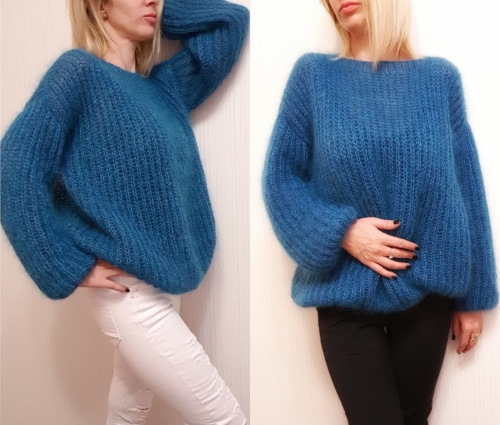
To work you need to prepare:
- Mohair from any company, 500 m per 100 g – 400 g.
- Needles No. 5.
It is better to knit it with a regular satin stitch, adding a 2 by 2 elastic band. For the model, you can use any openwork pattern or combination of patterns. If desired, you can knit braids or bobbles on the main fabric or sleeves.
The pattern of the oversized sweater is extremely simple. These are 2 large rectangles for the back and front with a V-neck in the front and 2 sleeve pieces with an extension from the elastic to the armpits.
Step by step knitting:
- The work should start with the back part. To do this, you need to knit a rectangle with the front surface or any chosen pattern.
- Then knit the front piece in the same way as the back, but before reaching 15-20 cm to the top of the piece, divide the work into 2 equal parts and form a neckline.
- You need to divide all the loops into 3 parts. The central loops are the neck loops and the side parts are the shoulder loops.
- The neckline needs to be formed by decreasing 1 loop in each front row from the neck side until only the shoulder loops remain in the work. Finish the shoulders separately to the desired height.
This neckline can be left untreated, the model suggests a certain casualness and the free edge of the neckline will match the style.
- Knit 2 identical sleeve parts. To do this, cast on stitches and knit a 2 by 2 elastic band to the desired height.
- Switch to stocking stitch or chosen pattern. Knit to a height of 40-50 cm, evenly adding 1 loop on each side every 10 rows.
- Then sew all the pieces together. If you knit a sweater long enough, you can wear it with a wide belt, like a tunic.
You can decorate this oversized model with patch pockets or use yarn of several shades in your work, forming contrasting stripes.
With raglan sleeve
The mohair sweater with knitting needles, the diagrams and description of which are discussed below, is knitted in one piece from the top and has a raglan sleeve.
This knitting method is loved by many, as there is no need to sew the parts after work and the finished product is immediately visible, which can be tried on during the work. To create this model, you need knitting needles on a fishing line of the desired number and mohair. First, as usual, a sample is knitted, the knitting density and the number of loops for the set are calculated.
When knitting with mohair, you can use the simplest knitting pattern - stockinette stitch, since the thread itself will decorate the product. And if you choose mohair with lurex or sequins, then the patterns will be superfluous.
Work starts from the neck:
- You need to cast on the required number of stitches on circular knitting needles and close the work in a circle. Knit 5-7 cm with a 2 by 2 or 1 by 1 elastic band, switch to stocking stitch.
- Calculate the raglan loops. You need to select, for example, 2 loops for each raglan line (4 raglan lines with 2 loops = 8 loops). Subtract 8 from the total number of loops. Divide the remaining number by 3. One third are the back loops, one third are the front loops, and one third in half are the sleeve loops.
- Next, knit the sprout with shortened rows if desired. You can skip this step if you plan to have a wide neckline.

- Then knit in a circle, making increases of 1 loop in every second row before and after each raglan line. Knit the expansion of the fabric until the raglan reaches 20 cm (approximately for size 46).
- Transfer the sleeve loops to the thread, continue working in a circle on the front and back pieces, while in the first row, cast on 6 loops between them for the undercuts.
- Finish the main piece with an elastic band and close the loops.
- Finish each sleeve in turn.
The sweater is ready. You only need to make 2 small undercut seams. In this model, you can use any openwork pattern for the main part of the sweater or for the sleeves.
Children's models
Children's sweater models made of mohair look cozy and warm. But you shouldn't choose this yarn for knitting for babies because of its fluffiness. The cut of mohair children's sweaters can be simple. They will still look interesting due to the texture of the yarn.
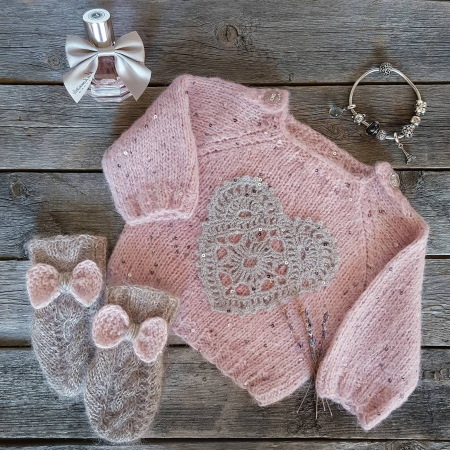
For children, you can use openwork. Mohair braids do not look so impressive. For children, experts advise choosing a thread on a natural silk base. It is softer. Since any mohair model will be almost weightless, it will become an indispensable thing for warming in the cold and will decorate the baby.
Male models
Mohair is not used so often for men. But there are models that look brutal and stylish. You can combine several shades of mohair in one sweater, for example, knitting a yoke from dark yarn, and the bottom of the product from a lighter one. Striped mohair sweaters for men will look beautiful.
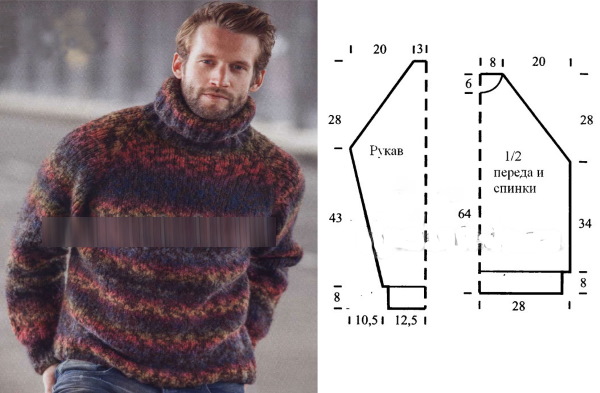
For knitting, men should choose smaller knitting needles so that the fabric is denser and less fluffy. Mohair sweaters for men are knitted either with a stockinette stitch or with a rib stitch. A voluminous rib stitch is a good option for a stylish sweater or turtleneck.
For teenagers
For teenagers, models made from bright yarn are good. You can use the description and patterns of adult options with the recalculation of the number of loops and rows for the desired size. Oversized models are popular among young people. They are suitable for any size and style of clothing.
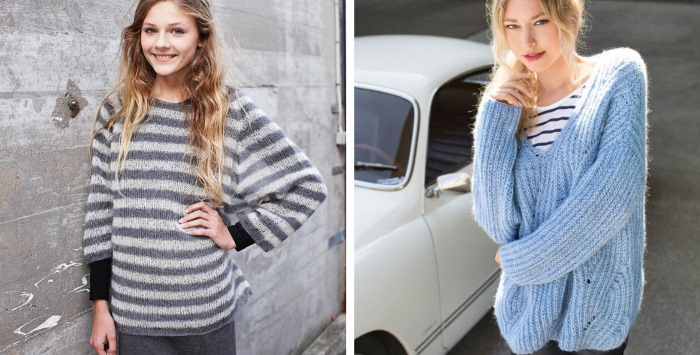
Today it is fashionable to combine fluffy yarn with smooth yarn in one product. Trim, strips or elastic band made of cotton or smooth wool yarn in a mohair sweater will make it modern and stylish. This can be elastic band on the sleeves and bottom of the product, neck or connecting strips on the shoulders, armhole or side seams.
Slits or different lengths of mohair sweaters will add style. These features will be good not only for teenagers, but also for creating models for adults.
Any mohair sweater knitted with knitting needles according to the given patterns and descriptions will warm you on frosty winter days and will become a stylish addition to your wardrobe. It is very pleasant to work with such yarn, and wearing things made from it is a special pleasure.
Video about knitting mohair sweaters
Mohair sweater knitting patterns:

Was it really impossible to draw a standard pattern with a raglan for the first model (with the number of loops and patterns of decreases on the back, front, sleeves), and not talk about what it could be like. I am even surprised at the author who takes up the article and draws some incomprehensible "snake". This is still a possible option for a home-made preparation (for yourself), but for the article it was possible to work hard and describe everything correctly.